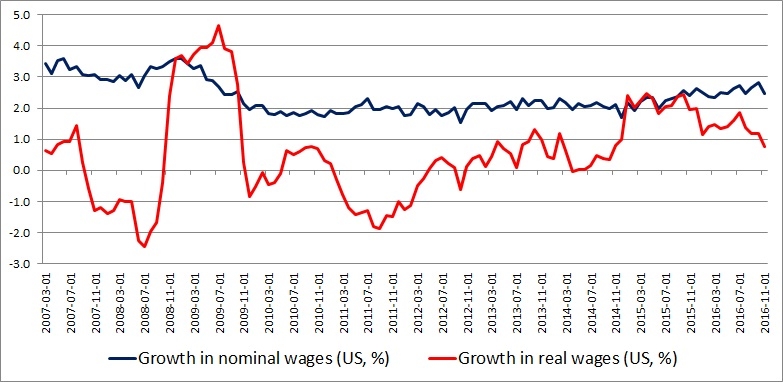The US Federal reserve is right to worry on looming inflation, as higher inflation without compensatory growth would eat away the purchasing powers of the consumers. In addition to that, a higher inflation uptick means that the FED would have to unwind its asset portfolio fairly quickly.
Since the great recession of 2008/09 the growth in the nominal wages in the economy remained fairly stagnant, despite a steady decline in the unemployment rate from 10 percent to 4.8 percent. Only since 2015, it has shown some upward pace. Several times, throughout the past year, several times the FOMC has mentioned in their statement that the household earnings remained solid and indicated in 2015 that the drop in the oil price would benefit the consumers by increasing their spending powers or real wages.
However, the same Federal Reserve failed to mention, what we can see from that graph that since November 2015 there has been a steady decline in real wages as inflation rose at a faster pace compared to the real wages. While the nominal wage growth (2.5 percent) has hit the highest level since the crisis, real wage growth (0.8 percent) has touched the lowest level in more than 2 years.



 How India’s economy has fared under ten years of Narendra Modi
How India’s economy has fared under ten years of Narendra Modi  Best Gold Stocks to Buy Now: AABB, GOLD, GDX
Best Gold Stocks to Buy Now: AABB, GOLD, GDX  Japan Posts 7.7% Growth in Machinery Orders
Japan Posts 7.7% Growth in Machinery Orders  FxWirePro: Daily Commodity Tracker - 21st March, 2022
FxWirePro: Daily Commodity Tracker - 21st March, 2022  The yen plunges to 34-year low despite interest rate hike
The yen plunges to 34-year low despite interest rate hike  New EU trade rules could put poor countries in a billion dollar ‘green squeeze’
New EU trade rules could put poor countries in a billion dollar ‘green squeeze’  How cuts to marginal income tax could boost the UK’s stagnant economic growth
How cuts to marginal income tax could boost the UK’s stagnant economic growth 






























